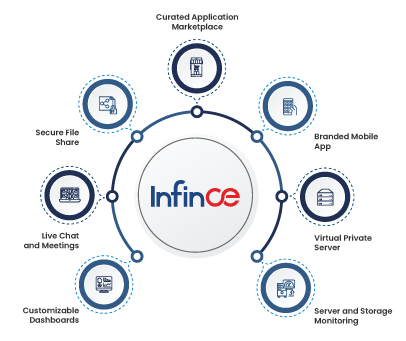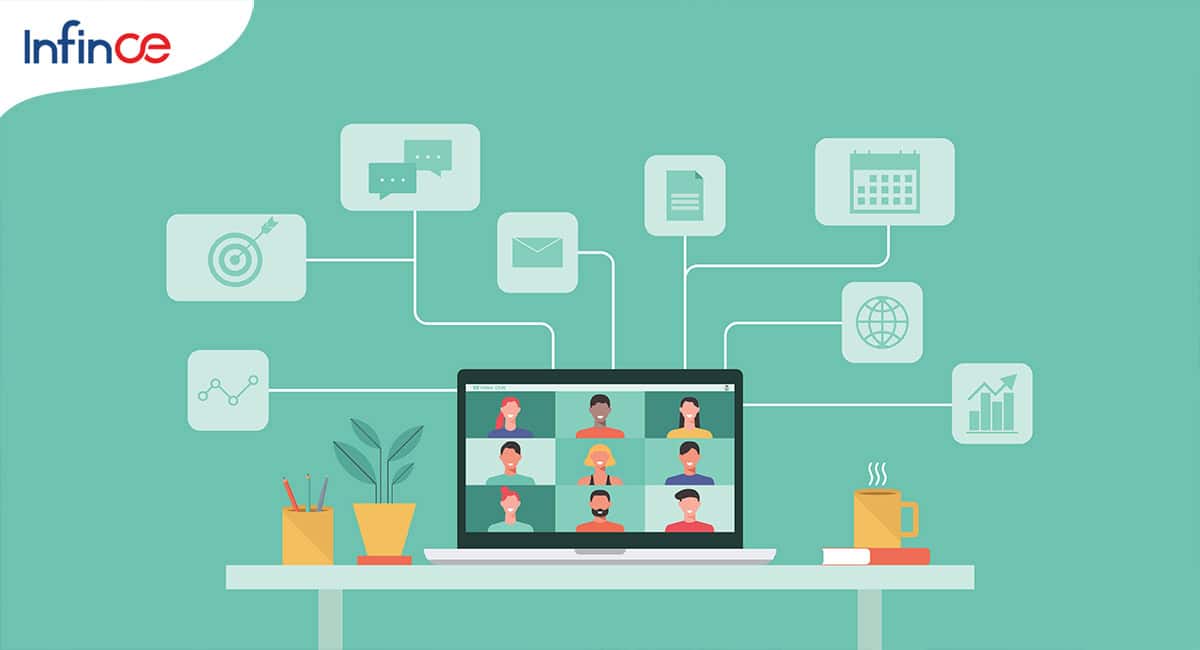Your company’s internal communications can say a lot about your organization, culture, and prospects. When all your team members feel connected and part of a single, unified structure, it denotes a positive and efficient work environment. If done rightly, internal communications can be the powerful engine that can drive productivity, collaboration, workforce engagement, and employee advocacy in your organization. Research shows that business leaders report positive effects when communication is done right – 60% notice more employee confidence, and 72% say it increases employee productivity.
Internal communication, however, isn’t as simple as greeting your coworker in a busy hallway. It takes a lot to deliver the right message to the right people in the right place at the right time with the right tone. From ineffective and unproductive day-to-day operations to a lack of proper cross-departmental communications and disengaged or disconnected staff, the impact of poor internal communications can be wide-reaching. Recent data shows that 72% of employees do not fully understand their company’s strategy, while 54% of employees believe they’d be more productive if they had more access to leadership.
Many organizations struggle with a confusing array of business communication issues that impede their development and productivity. Our essential guide will help you navigate the complex web of internal communications, explain its importance in the modern workplace, and offer tips for setting up or improving your organization’s internal communications strategy.
IN THIS GUIDE:
What is internal communications?
Why is internal communications important?
Tips to improve internal communications
Setting up a successful internal communications strategy
Using the right internal communications software
How InfinCE can enhance your internal communications process
Keep your team connected and informed with effective internal communications
What is internal communication?
In its simplest form, internal communication (IC) refers to processes and strategies used to communicate information and messages within an organization.
Announcements from executives and leadership, team or department updates, casual chats among colleagues, updates on projects or initiatives, company news, feedback on performance, and all other information relevant to the organization and its employees can fall under the broader term of internal communications.
In short, internal communications is the heartbeat that keeps all employees in-sync and in-the-know within your organization. Effective internal communications provide employees with more clarity about your organization’s objectives and goals.
Why is internal communication important?
“Internal communications can build a strong and cohesive culture, improve employee engagement, and ensure that everyone is working towards the same goals.” – Business Dictionary
Internal communication brings together employees and helps them make sense of the company’s goals. More than employers putting out messages, internal communications is part of a dialogue that helps a company better know what employees need. Here’s why it’s important to fundamentally incorporate internal communications into your overarching business strategy.
- Keep employees informed: Effective internal communications can ensure that everyone in your organization is on the same page and working towards the same goals. By staying up-to-date with the latest company news and changes in strategy, your team will be able to execute their jobs efficiently and maintain better relations with other staff.
- Improve employee engagement: Effective internal communications can help you keep your employees engaged and motivated, which most often leads to higher productivity and loyalty. Higher levels of employee engagement create a positive domino effect on your business performance.
- Build a positive workplace culture: Messages communicated from the leadership to your staff will influence how they interpret your company’s values and beliefs. A positive workplace culture has a considerable impact on your people and their levels of engagement with work, which in turn leads to higher staff retention.
- Facilitate feedback and discussion: Internal communications can create a healthy space for dialogue within your organization. By encouraging effective feedback,discussion,n and debate, your company can identify ways to improve and also avoid making the same mistakes in the future.
- Provide clarity into roles and expectations: A clear internal communication strategy helps provide clear expectations to your staff about what they are supposed to do. This can prevent a possible disconnect between your staff and customers, and even improve customer service.
- Foster innovation and new initiatives: Effective internal communication can create a culture of innovation, where employees feel empowered to share ideas and collaborate on new initiatives. A work environment that encourages the exploration of different viewpoints helps create a culture of continuous learning and improvement.
- Retain the best talent to stay competitive: A robust internal communications strategy helps take a more proactive approach to employee engagement by creating a work environment that fosters growth, creativity, and a sense of purpose. It helps your company to remain competitive by retaining the best talent.
Tips to improve internal communications
Let’s take a look at some of the internal communications best practices that can help you build a productive, well-informed, and engaged workforce.
- Optimize your communication channels: Choose communication tools, channels, or methods depending on the message that you want to get across. For instance, social media can be a good choice to advertise your job openings, while an online chat tool can be the best option for instant messaging or to quickly share internal documents. Adopting a unified, multi-channel approach facilitates better workplace collaboration and co-creation.
- Incorporate feedback loops: Feedback is imperative to building a great culture at work through improved internal communications. People want to know that their ideas and perspectives are valued. Evaluate your internal communications plan regularly. Gather employee feedback on what they think about your internal communications process through anonymous online surveys, group discussions, or one-to-one meetings.
- Celebrate wins and achievements: Making your staff feel valued for their contributions will help motivate them to work harder to accomplish your organizational goals and objectives. Sharing the successes and milestones achieved by your team through a common internal communications platform, such as intranet software, will help build a positive workplace culture and inspire employees to actively connect with the work they do.
- Break down information silos: When employees are unified in their understanding of the company goals, they will be able to communicate with one another more effectively in order to reach them. Take time to explain the company’s values and mission, whether as part of corporate training or as a regular reminder to employees. When employees are instantly informed about the latest business news and are connected with the rest of the team, they feel less frustrated or isolated.
- User-friendly intranet software: Modern workforce requires a robust internal communications solution that reflects the world they live and work in. Use a cloud and mobile-friendly intranet software branded to your requirements. It will provide your employees with all the information and collaboration tools they need to do their jobs efficiently.
Setting up a successful internal communications strategy
Developing an effective internal communications strategy requires careful planning and consideration. These six steps will ensure your internal communications plan unites your employees with your core business goals.
1. Analyze your current IC strategy
Before developing a new internal communications plan, take a look at your current strategy to identify what needs to be improved, discarded, or retained.
The best way to find out what could be improved is by asking your team, the people who use the internal communication tools like intranet every day. Identify their pain points to understand what could be made better.
Employee surveys and group discussions involving representatives from diverse teams or departments are some of the best ways to find out what people think.
2. Determine the key metrics
Identify the most important metrics that can help define your internal communication goals and measure the success of your strategy. We recommend looking at these metrics:
- Employee engagement: Do your employees feel heard, share their ideas and feedback, receive and discuss internal content and updates, and share company values?
- Project management: Are your employees happy with your current project management tool/ process? What are the constant issues faced?
- Social shares: How often are your employees sharing your content and business updates that make them feel more connected with your brand’s goals?
- Employee referrals: How many candidate referrals do you currently receive from your employees?
3. Decide if technology could improve your IC
If you aren’t using a company intranet or require a robust tool to streamline your internal communications, now’s the time to invest.
A modern workplace intranet helps integrate many different tools to make your internal communications easier. For instance, an intranet can integrate with and leverage a horde of workplace collaboration and productivity tools such as instant messenger (chat) app, cloud-based file storage drive, project management tool, video meeting software, business phone system, online Office tools, and so on.
Consider technology that:
- Delivers a rewarding and unique communication experience to your staff
- Keeps everyone in your team updated with the latest information
- Facilitates adequate communications planning and tracking
- Offers social capabilities to encourage employee interaction and engagement
- Guarantees ease of use without posing any potential barriers to adopt and use additional technology
4. Set a realistic timeline and budget
Timelines and budget will influence how far things can change.
For example, your company may require a completely new intranet or may need to only update parts of the existing intranet, such as adding a social network, a mobile application, or an integrated search solution. The decision depends on how much your budget allows for.
Similarly, timelines should be set in a realistic manner to ensure that changes take place on time. Are there other projects that this might be contingent upon? What’s the status of staff availability? And how much time do you need to incorporate the necessary changes? All these should be considered.
5. Inform employees, so they can adapt quickly
Inform employees about what’s happening so they can easily align themselves with the new internal communication strategy. Employees need meaning and a clear vision in order to fully engage with the job and to understand why their input is valuable to the company achieving its goals.
Run a contest among your teams to come up with an interesting name or a creative design theme for your new IC strategy. Create a diverse group of champions who can promote adoption, usage, and engagement. These are some of the great ways to put the new internal communications plan in place.
6. Review and improve
Evaluate your key performance indicators (employee engagement & feedback, project management, social media metrics, content reach, etc.) regularly. Learn from them and continually optimize what you are doing for the best results possible.
Run routine pulse surveys to understand how employees are feeling about your communication content and cadence. Some questions that you could ask include:
- Can you rate the effectiveness of our internal communications on a scale of 1 to 5 (1 being poor and 5 being the best)?
- Are our business communications and updates making our company vision transparent enough for you?
- Are there any setbacks that prevent you from working with others on projects?
- Do you believe we could improve cross-departmental communication?
- What barriers prevent you from communicating internally each day?
- Where can we improve the most on company communication?
Regular evaluation of your internal communications strategy will help people know that you’re listening to them. It will also allow you to plan on adjusting your strategy to promote transparency and trust.
Using the right internal communications software
As more and more teams move to remote and hybrid working models, the need for effective internal communications is growing.
Internal communications software can help everyone stay up-to-date on the latest company news, announcements, updates, events, content, projects, and documents. There are different types of internal communication tools that can facilitate a strong communication strategy within your company.
1. Company Intranets
A company intranet is a centralized information sharing hub where employees can access all the information and tools they need in a single platform. One of the most important benefits of an intranet is that it connects all employees from multiple locations (remote/ hybrid/ in-office teams), so they can stay up-to-date on company news and events.
Company intranets often come with features like social feeds, instant messaging, secure file sharing, and integration with other enterprise tools. Teams and departments can use a company intranet to share relevant documents, articles, charts, etc with large groups of employees.
2. Online Collaboration Tools
Online collaboration tools offer a variety of features, including instant messaging, video conferencing, and file sharing, making it easy for teams to chat, share files, and work on projects together.
Collaboration tools facilitate more effective teamwork by linking teams from different departments or even time zones, so they can work together, track task progress, and stay in sync to reach their common goal.
3. Project Management Tools
Using a project management tool, employees can not only share files, but also track projects, set deadlines, and assign tasks. Many organizations integrate their employee communication software with a project management tool to make their workflow more efficient and streamlined. Project management software is ideal for organizations that need to manage complex projects and large teams.
4. Instant Messaging Tools
Instant messaging or online chat tools facilitate real-time exchange of messages between team members working from anywhere. Instant messengers are frequently used by employees at all levels on a daily basis to ask questions, confirm meeting dates, clarify queries, or share ideas quickly.
Instant messages are a convenient way to quickly exchange information and are sometimes more practical than picking up the phone for a quick question. Modern instant messaging tools offer features such as emojis (or graphical smileys), file transfer, chatbots, voice over IP, and video chat capabilities to make conversations more effective and engaging.
How InfinCE can enhance your internal communications process
InfinCE isn’t just another internal communications software. At its core, it is a complete digital workplace designed to support and enhance your internal communications processes. InfinCE combines multiple workplace tools and components into a single suite, so your employees can perform their best with minimal obstacles.
Here’s a closer look at what InfinCE offers and how it could be the game-changer for your organization’s internal communications plan:
- Collaboration Apps for employees to coordinate at work more efficiently, including employee directory, live chat, video conferencing, and private email.
- Productivity Tools that help perform your day-to-day organizational activities like task management, calendar, document creation, and sharing.
- Ready-to-Use Online Office Tools: Documents, Spreadsheets, and Presentations raise your employees’ productivity. Employees can easily share and collaborate on documents and get the work done quickly.
- Secure File Sharing: Files can be securely shared between employees, but also between employees and non-employees using options like upload-only folders and password-protected files.
- Data Visualization Dashboards: Users can create custom dashboards to help them keep track of what’s happening in their project or team. It provides an effective way to communicate key business information in real-time and simplifies team collaboration.
- Employee Engagement Mobile App: Stay on top of your work, view dashboard updates, access work files, find contacts, join video meetings, and do a lot more with the intuitive InfinCE mobile app.
Keep your team connected and informed with effective internal communications
A highly engaged team that comes to work every day with excitement and purpose will have a direct impact on your bottom line. The ultimate purpose of an internal communications plan is to drive cultural change, break down communication barriers, transform employee experience, boost workforce engagement, and foster innovation and growth.
From integrating email and instant messaging to virtual meeting software and custom business dashboards, InfinCE offers all the tools you need to implement an entirely new working environment that replicates your employees’ changing work experience.
If you’re looking for new internal communications software for your business, InfinCE is here to help. Book a demo of InfinCE and see for yourself how it can help your business.















































